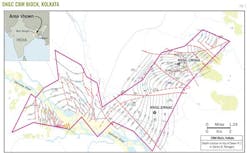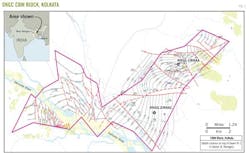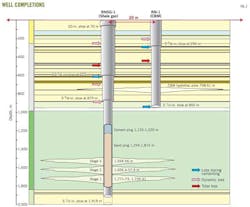Santosh Kumar Das
Rajiv Gandhi Institute of Petroleum Technology
Raebareli, India
Although the first test of a shale-gas reservoir in India failed, plans for other tests continue.
The first shale well (RNSG No. 1) was drilled by Oil and Natural Gas Corp. Ltd. (ONGC) in cooperation with Schlumberger in Ichapur village near Durgapur, West Bengal (Fig. 1).
Fig. 1 also shows the location of RNSG No. 2, drilling of which is under study.
Other promising regions for shale-gas exploitation are Cambay in Gujarat state, Assam-Arakan in northeast India, and Raghavapuram shale on India's east coast.
One complication in India is that the government-issued leases for conventional petroleum exploration do not include unconventional sources such as shale gas. Gas from shales is not even mentioned in the petroleum ministry's plan for Indian energy through 2025.
According to the preliminary estimates, India's shale-gas resources may be larger than its conventional gas resources. Schlumberger estimates that India may have a 600-2,000 tcf shale-gas resource. The US Geological Survey also will be carrying out studies on India's shale-gas resources and will provide a report.
Supply of natural gas in India lags behind demand, and by 2015 gas demand may rise to 120 billion cu m/year from the 62 billion cu m/year in 2010.
First shale well
India's first shale-gas well, RNSG No. 1, was shut down on Sept. 20, 2010, due to problems with the casing, high water-cut production, and high surface pressure.
ONGC drilled the well to about 2,000 m and set a 51⁄2-in. casing shoe at 1,919 m (Fig. 2). The float collar was at 1,878.5 m.
The major complications while drilling included:
• Partial dynamic mud losses from about 243 m and total mud losses from 492-520 m while drilling the 171⁄2-in. section.
• Mud losses while running and cementing the 133⁄8-in. casing.
• Partial dynamic mud losses from about 693 m in the 121⁄2-in. section but no losses while running and cementing the 95⁄8-in. casing. The completion of this section included a casing packer set at 608 m and a two-stage cement job.
• Partial dynamic losses immediately on drilling resumption at 890-1,003 m in the 81⁄2-in. section. Two cement squeeze jobs stopped the losses, and the well did not encounter losses while the 51⁄2-in. casing was run and cemented. The cement top was at 800 m.
ONGC used a three-stage hydraulic fracturing job on the well.
The first stage was in the intervals 1,771-73 ft and 1,726-31 m, perforated with six shots/ft. Total slurry injected was 1,649 (4,463 lb proppant) and 3,938 bbl (20,208 lb proppant), respectively, with an average treating pressure of 8,403 psi.
The second stage was in the interval 1,658-56 m, perforated at 12 shots/ft. Total slurry injected was 2,726 bbl (53,866 lb proppant) with an average treating pressure of 7,888 psi.
The third stage was in the interval 1,656-54 m, perforated at 12 shots/ft. Total slurry injection was 6,167 bbl (111,057 lb proppant) with an average treating pressure of 6,799 psi.
Fig. 3 shows the frac pressure response.
One major problem was that the planned temperature log could not be run due to high surface pressure. In addition, very high surface pressure prevented the planned job to be fully completed. The high pressure also made it hard to shut down the job.
Displaying 1/3 Page1, 2, 3Next>
View Article as Single page



